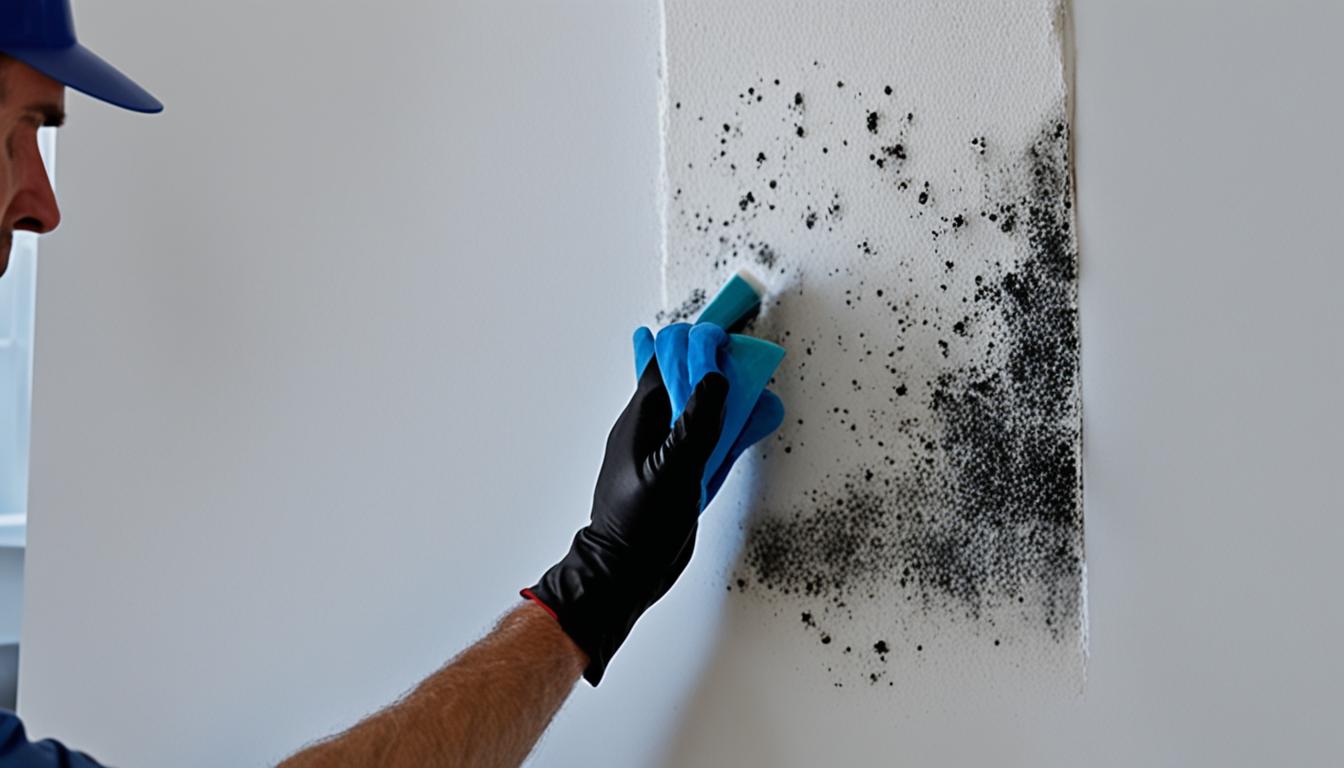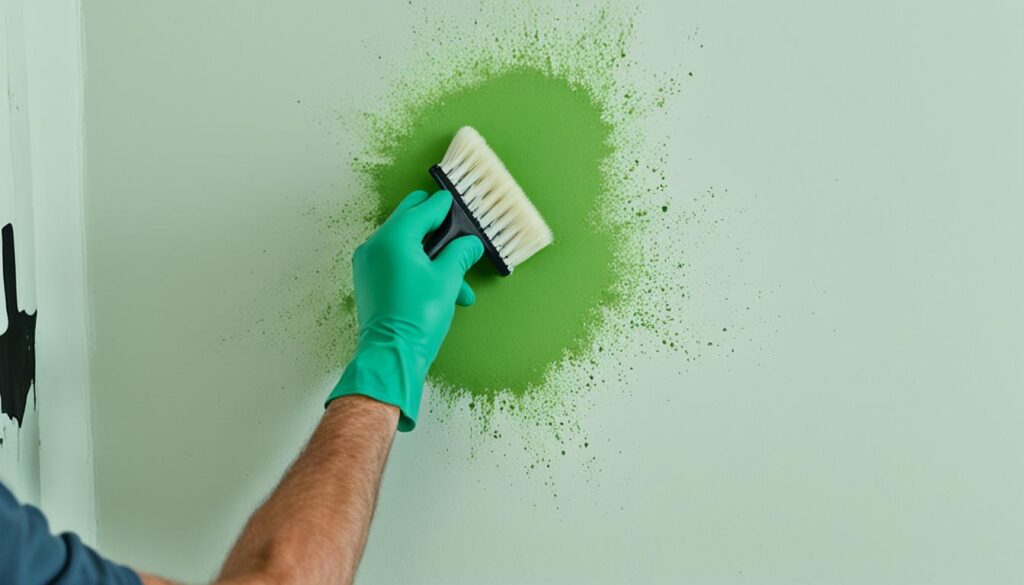
Removing Mold from Drywall Florida | Expert Tips
Welcome to our informative guide on removing mold from drywall in Florida. Dealing with mold growth can be a common concern for homeowners in this humid climate. Whether you have noticed visible signs of mold or are taking preventive measures, it is essential to understand the proper techniques for mold removal to ensure the safety and well-being of your home.
Key Takeaways:
- Florida’s humid climate poses unique challenges for mold growth on drywall.
- Effective mold removal requires proper knowledge and techniques.
- Immediate action is necessary to prevent health risks and further damage.
- Both DIY methods and professional assistance should be considered.
- Seeking a professional mold assessment can ensure thorough removal.
Understanding the Importance of Mold Removal
When it comes to maintaining the well-being of your home, mold removal should be a top priority. The presence of mold can have detrimental effects on both your health and the structural integrity of your drywall. Immediate action is necessary to mitigate the potential risks and damage caused by mold.
The Health Risks of Mold
Mold releases spores into the air, which can be inhaled and trigger allergic reactions or respiratory issues. Individuals with weakened immune systems, asthma, or allergies are particularly susceptible to the harmful effects of mold exposure. Symptoms may include coughing, sneezing, wheezing, watery eyes, and skin irritation.
Furthermore, certain types of mold, such as black mold, can produce mycotoxins that pose additional health hazards. Prolonged exposure to mycotoxins can lead to more severe respiratory problems, neurological symptoms, and even chronic conditions.
The Damage to Drywall
In addition to health risks, mold can cause significant damage to your drywall. As mold grows and thrives, it feeds on organic materials, including the cellulose present in drywall. This can weaken the structural integrity of the drywall, leading to cracks, warping, and even potential collapse if left untreated.
Moreover, mold stains can be unsightly and challenging to remove, often necessitating extensive cleaning and repainting. In severe cases, the affected drywall may need to be replaced entirely, resulting in costly repairs.
The Need for Immediate Action
“Mold is not something to ignore or underestimate. The longer you wait to address the issue, the more extensive the damage can become. Act promptly to protect your health and preserve the integrity of your home.”
Given the potential health risks and damage associated with mold, it is imperative to take immediate action for effective mold removal. Addressing the problem promptly not only safeguards your well-being but can also save you time and money in the long run.
Next, we will explore the various methods that can be employed to effectively remove mold from drywall in Florida. Whether you choose to tackle the task yourself or seek professional assistance, it’s vital to be well-informed and equipped with the right knowledge.

Comparison of DIY and Professional Mold Removal Methods
| DIY Mold Removal | Professional Mold Removal |
|---|---|
| Requires extensive research and preparation | Expert knowledge and experience |
| Less costly | Higher upfront cost |
| Potential risks if not done correctly | Guaranteed professional results |
| May be suitable for small-scale mold issues | Recommended for extensive or recurring mold problems |
As you can see from the table above, there are advantages and considerations to both DIY mold removal and seeking professional help. Our next section will provide detailed insights into these methods, enabling you to make an informed decision based on your specific circumstances.
Effective Methods for Removing Mold from Drywall in Florida
When it comes to removing mold from drywall in Florida, it is important to employ effective methods that ensure a thorough and long-lasting solution. Whether you prefer a do-it-yourself approach or seek professional assistance, understanding the right techniques is essential for successful mold removal.
1. Identify the extent of the mold infestation
Before addressing mold removal, it is crucial to assess the severity of the infestation. Inspect the affected area thoroughly, checking for visible signs of mold growth, such as discoloration, musty odors, or water damage. Identifying the extent of the mold problem enables you to determine the appropriate course of action.
2. Safety precautions
When dealing with mold, it is vital to prioritize safety. Protect yourself by wearing personal protective equipment, including gloves, goggles, and a respirator mask. This helps minimize the risk of inhaling mold spores and protects your skin from contact with potentially harmful substances.
3. DIY methods
If the mold infestation is minor and limited to a small area, you may opt to remove it yourself. DIY methods include:
- Bleach solution: Create a mixture of one part bleach and three parts water. Apply the solution to the affected area, scrub gently, and allow it to sit for 15 minutes. Rinse with clean water and ensure proper ventilation during the process.
- Vinegar: Vinegar is a natural mold killer. Apply undiluted vinegar to the affected area, let it sit for an hour, then scrub and rinse with water.
While these DIY methods can be effective for small-scale mold removal, it’s important to note that they may not eradicate the root cause of the mold growth. Without addressing the underlying moisture issue, mold can recur.
4. Professional methods
For extensive mold infestations or recurring mold problems, seeking professional assistance is highly recommended. Professional mold remediation experts are equipped with the knowledge, experience, and specialized equipment to effectively detect and remove mold.
They employ advanced techniques such as:
- Mold testing and inspection: Professionals conduct comprehensive mold assessments to identify the type, extent, and source of mold growth. This helps in formulating a targeted and effective removal plan.
- Air filtration and containment: Professionals use advanced filtration systems and create containment barriers to prevent the spread of mold spores during the remediation process.
- Mold removal and remediation: Certified professionals follow industry-standard protocols to safely remove mold, including thorough cleaning, disinfection, and application of mold inhibitors to prevent future growth.
By engaging professionals, you can ensure a thorough mold removal process, addressing the underlying moisture issue, and preventing mold recurrence.

Remember, mold removal from drywall in Florida requires effective methods and a comprehensive approach. Whether you choose the DIY route or seek professional assistance, always prioritize safety and address underlying moisture issues to maintain a mold-free environment in your home.
Conclusion
In conclusion, removing mold from drywall in Florida requires proper knowledge and effective techniques. Mold can pose serious health risks and cause significant damage to your home if left untreated. Therefore, it is crucial to take immediate action when you discover mold in your drywall.
By following the expert tips provided in this article, you can effectively address mold issues in your home. Remember to identify the source of moisture that is causing the mold growth and fix it to prevent future occurrences. Additionally, it is essential to properly clean and treat the affected area to ensure complete mold removal.
If you are unsure or overwhelmed by the severity of the mold infestation, it is advisable to seek professional assistance. Companies like Fix Mold Miami have the expertise and tools to conduct thorough mold assessments and provide effective remediation solutions. Don’t hesitate to contact Fix Mold Miami at 305-465-6653 to schedule a mold assessment or seek further guidance from their experienced team.




